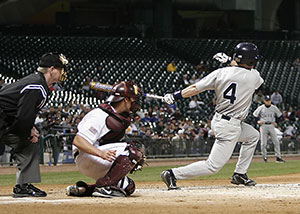Follow Through Interference
Pro rules have nary a reference to follow through interference. Instead, it is referred to as “back swing” interference. The golfing world knows the difference.
Follow through vs. back swing
The follow through is the continuing movement of the bat after the ball is struck or missed – the completion of the swinging motion. The back swing is a preparatory movement that involves just what it says – movement of the bat backwards. The batter does that just before he prepares to swing. As you’ll see, those two acts are treated very differently. Except where noted, the material applies equally to NFHS, NCAA and pro rules.
Should the umpire call time or interference?
NFHS now defines backswing interference as when a batter contacts the catcher or his equipment prior to the time of the pitch (2-21-5). If a batter, during his preliminary loosening-up swings, or when he cocks the bat to swing, hits the catcher or the catcher’s mitt, the umpire should immediately call time, and not interference. The pitch or swing should not be allowed since the batter’s concentration or rhythm could be affected (NFHS 8.1.1F, NCAA 8-2e AR, OBR 5.05b3 Comment 3).

Unintentional Follow Through Interference
Follow through interference
Follow-through interference is when the bat hits the catcher after the batter has swung at a pitch and hinders action at home plate or the catcher’s attempt to play on a runner (NFHS 2-21-4). The batter is entitled to swing at any pitch unhindered by the catcher, but once he does he is responsible for not interfering with any attempt by the catcher to make a defensive play. The follow through is the batter’s responsibility without exception, so unless the catcher jumps up and moves into the swing, if the bat hits the catcher on the follow through, it’s the batter’s fault.
If no play is in progress when the contact occurs, there cannot be interference. The pitch is called a strike, the ball is dead and no runner shall advance on the play. If there are two strikes on the batter and the follow-through causes an uncaught third strike, the batter is out and no runners can advance. If the contact occurs while the catcher is in the act of making a throw to retire a runner, the codes differ. In NFHS, the batter is out and the runner returns. In NCAA and pro, time is called at the end of playing action, the batter is only out on a third strike and runners return unless the catcher’s initial throw retires the runner (NFHS 7-3-5c; NCAA 6-2d1, 6-2d2; OBR 6.03a3 Comment, PBUC 7.13).
Play: With a runner on first and a 1-0 count, B1 swings and misses the pitch. His follow through on the swing comes around and hits the ball out of F2’s glove immediately after he securely catches the pitch. R1 then goes safely into second base.
Ruling: In NFHS, B1 is out and R1 returns to first base. Under NCAA and pro rules, a strike is called on B1 and R1 returns to first base.

